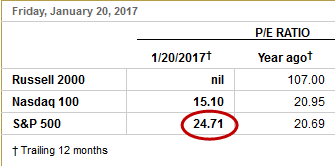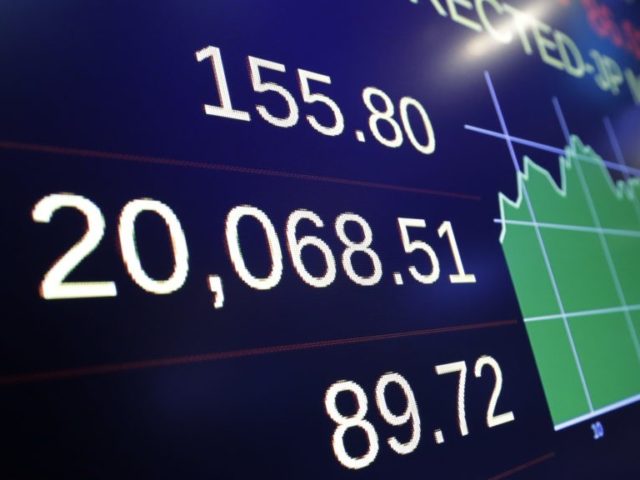This morning’s key headlines from GenerationalDynamics.com
- Dow surges past 20,000, further expanding dangerous Wall Street bubble
- China desperately imposes controls on capital outflows
Dow surges past 20,000, further expanding dangerous Wall Street bubble

S&P 500 Price/Earnings ratio at 24.71 on Jan 20, indicating a huge and growing stock market bubble (WSJ)
President Donald Trump and the “Trump effect” are being given credit for pushing the Dow Jones Industrial Average past 20,000 on Wednesday, for the first time in history. The credit is being given to Trump because of the excitement generated by his election victory and his divisive moves in the direction of rolling back regulations that have hampered businesses and job creation.
The operative word is “excitement.” There is little or nothing of real economic fundamentals that justify this continually growing stock market bubble. Central banks around the world have been printing money and pumping it into the banking system. Investors borrow that money and use it to buy stocks and sell them to each other, pushing up stock prices and stock market indexes.
Furthermore, this was going on in the Barack Obama administration as well as the Trump administration. Stock market bubbles have no connection to politicians, either conservative or liberal.
According to Friday’s Wall Street Journal, the S&P 500 Price/Earnings index (stock valuations index) on Friday morning (Jan 20) was at an astronomically high 24.71. This is far above the historical average of 14, indicating that the stock market bubble is still growing, and could burst at any time. Generational Dynamics predicts that the P/E ratio will fall to the 5-6 range or lower, which is where it was as recently as 1982, resulting in a Dow Jones Industrial Average of 3000 or lower.
There is a lot of Schadenfreude going around about the election night New York Times blog entry by Paul Krugman, who was awarded the Nobel Prize in Economics because of his hatred of President George Bush. After Donald Trump’s election victory, Krugman wrote:
It really does now look like President Donald J. Trump, and markets are plunging. When might we expect them to recover?
Frankly, I find it hard to care much, even though this is my specialty. The disaster for America and the world has so many aspects that the economic ramifications are way down my list of things to fear.
Still, I guess people want an answer: If the question is when markets will recover, a first-pass answer is never.
Under any circumstances, putting an irresponsible, ignorant man who takes his advice from all the wrong people in charge of the nation with the world’s most important economy would be very bad news. What makes it especially bad right now, however, is the fundamentally fragile state much of the world is still in, eight years after the great financial crisis.
What this goes to show is what an idiot Krugman is, but not because he is wrong about the “fundamentally fragile state” of the world. He is actually right about that, and that is consistent with the Generational Dynamics view of the world.
And that is particularly ironic, because Krugman is agreeing with the thrust of Trump’s inauguration speech, which linked America today to the economic hardships of the 1930s.
What makes Krugman a total idiot is that he thinks that he can time the market. You would think that the Nobel prize winner in economics would know that he can’t write a column late at night predicting stock prices the next day and expect to get them right. But then again, Krugman didn’t get his Nobel prize in economics because he is a good economist. The loons in Sweden gave it to him because they hated Bush and they wanted to give it to someone else who hated Bush as much as they did. So Krugman and the loons in Sweden deserve each other.
An economist would/should know that you can’t predict the timing of a stock market panic and crash. I always like to point out that even today, 87 years after the stock market panic of October 1929, nobody knows why it happened at exactly that time, and not three months earlier or five months later, and what triggered the 1929 panic. It is still a mystery.
A P/E ratio of 24.71 is astronomically high. And since stock prices have surged since Friday morning, the P/E ratio after Wednesday’s close is probably now above 25.
We can’t predict exactly when a stock market panic will occur, or what will trigger it, but we can predict with 100% mathematical certainty that a panic and crash will occur, and by the Law of Mean Reversion, the Dow Jones Industrial Average will fall from its current level of 20,000 to a low below 3,000, wiping out millions of people’s savings. CNBC and Bloomberg and NY Times (9-Nov-2016)
Related Articles
- Earnings fall, but central bank liquidity floods markets, pushing up stocks (30-Jul-2016)
- President Trump’s inauguration speech links today’s America to the 1930s (21-Jan-2017)
- Explanation of Price/Earnings ratio and Stock Valuations (28-Aug-2015)
- Wharton School’s Jeremy Siegel is lying about stock valuations (14-Apr-2012)
China desperately imposes controls on capital outflows
With the world’s economies interlocked, the trigger for a Wall Street panic and crash needn’t necessarily come from the United States. A financial panic in any major world economy could create a chain reaction that would affect all world economies.
In China, there is already a panic of sorts going on, as wealthy Chinese have been converting their fortunes from China’s yuan currency into dollars or other foreign currencies, and then using those dollars to purchase assets outside China. In that way, Chinese investors protect themselves from a currency or stock market crash within China.
This has resulted in huge outflows of China’s yuan currency, as much as $1.3 trillion in the last four months of 2016. As more and more investors sell their yuan currency, the yuan weakens and its exchange rate becomes less and less favorable against the dollar. The value of the yuan lost 7% against the dollar in 2016. In the last few months, the yuan fell at its fastest rate since 1994.
Chinese investors, seeing the yuan weaken, then become anxious and convert more yuan into dollars in order to preserve value. This can create a vicious cycle that leads to a full-scale currency panic that would affect China’s entire economy.
As a result, China at the beginning of January issued regulations designed to clamp down on currency outflows. Chinese investors will be strictly limited in the amount of money that they can convert to dollars, and even then they must sign a pledge that the funds “will not be used for overseas purchases of property, securities, life insurance or any other insurance of an investment nature.”
China’s government says that these are not really capital controls, but are meant to prevent investment in terrorist activities abroad.
However, these new regulations are having a chilling effect on international investors considering investments in China. A person is not going to be willing to send dollars into China to invest in a business if they’re concerned that they’ll lose all their money because Chinese regulators won’t let them take it out of China later.
China’s new capital outflow limitations are a move of desperation that will not work forever. China Daily (5-Jan) and Radio Free Asia and Business Insider and Reuters
Related Articles
- China’s Xi Jinping congratulates himself on stopping stock market crash (24-Sep-2015)
- Global trade plunges as China’s economy becomes deflationary (11-Nov-2015)
KEYS: Generational Dynamics, Price/earnings ratio, Trump Effect, Paul Krugman, Law of mean reversion, China, currency controls
Permanent web link to this article
Receive daily World View columns by e-mail

COMMENTS
Please let us know if you're having issues with commenting.